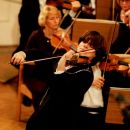12th International Henryk Wieniawski Violin Competition
Poznań, 13-29 October 2001
Watch a documentary about the competition:
It was not a revolution, although undeniably a radical step for the Wieniawski Competition to cross the threshold of the 21st century with confidence. Without losing anything from its legacy, bearing in mind its principles and beautiful episodes graced with names of laureates worthy of the patron, after long and thorough deliberations, it was decided that the fortunes of an international competition organized in Poland should be partially entrusted to an authority from outside the native milieu. “What we want from the violinists is everything. We are looking for diamonds. We are not looking for somebody who should perform best in a competition, but for somebody who will be able to seriously convey the past into the future. Above all, we want great artistry”, said Shlomo Mintz on the eve of the 12th Competition.
It was already one and half years earlier that he got involved in the preparation of the programme, which he wanted to see well-balanced. “Too much salt or pepper can spoil any dish”, he repeated and insisted on appropriate proportions between Wieniawski’s compositions and works by other well-known masters. “It is supposed to be an international competition!”. “Indeed. That’s exactly what we have been dreaming of”, replied Andrzej Wituski, Chairman of the Wieniawski Society and Director of the 2001 Competition, “however, one not deprived of Polish music”. Thus, the Board of the Society decided to commission with Krzysztof Meyer a piece to be performed by all participants in Stage One of the Competition; at the same time the players were “treated” to obligatory performance of Schubert’s Rondo, the jury chairman’s favourite piece. It was not without squabbles that Shlomo Mintz finally managed to force through his idea for the final stage: orchestrated versions of Wieniawski’s Polonaises besides the customary concertos...
Then came the time to compose the jury. Correspondence was exchanged with the whole world. Greatest celebrities were telephoned. Many expressed their interest; fewer were ready to have 14 days taken away from their engagement calendar. Nevertheless, the magnet of the jury chairman’s name proved evidently effective when full information about the competition was released. At long last, a stream of applications with interesting CVs, recommendations from renowned schools and distinguished teachers flowed in from different directions.
It took a long period of hesitation before the task of preliminary selection of these applications was entrusted to a s i n g l e person. Of over one hundred audio cassettes containing short recitals by anonymous musicians, Shlomo Mintz had to choose roughly one in two. He did the job with utmost integrity. Nobody questioned his competence as well as his will to be guided solely by artistic criteria and own perception of art. The opening concert, which was held on 13 October 2001, during which Shlomo Mintz delivered — to quote a critic — a truly “kingly overture”, also meant for him the end of a long and emotional preparation phase. It was followed by a two-week “diamond hunt” with a team of thirteen just ones. Gems were found in abundance and almost none were overlooked. The greatest and most precious came from Kazakhstan, with a Korean, Yugoslavian, Armenian, American, Japanese, an Englishwoman, a Frenchman and four Poles right behind the “golden” Russian. In the end, the group of laureates and distinction holders performed a piece with those who had selected them. It was a truly memorable accord. As was the entire competition: seemingly the same as before, and yet very different. Undeniably not perfect, yet inviting to follow in its footsteps, compelling one to take up
new challenges. In five years da capo...
source: R. Połczyński, Da Capo. 75 lat Międzynarodowych Konkursów im. Henryka Wieniawskiego
Read more about the 12th Competition (PDF, 764 KB) >

A poster of 12th edition of Wieniawski Violin Competition designed by Yenec Piskorski Studio 37.
JURY MEMBERS
Chairman: Shlomo Mintz
Cara Mia
Antonello
Victor Danchenko
Dorothy DeLay
Eduard Grach
Tuomas Haapanen
Koichiro
Harada
Jadwiga Kaliszewska
Herman Krebbers
Konstanty Andrzej Kulka
Paul
Ostrovsky
Alexander Povolotsky
Wanda Wiłkomirska
PRIZE WINNERS
1st prize: Alena BAEVA (Russia)
2nd prize: Soojin HAN (Korea), Roman SIMOVIĆ (Yugoslavia)
3rd prize: Gaik KAZAZIAN (Armenia), Bracha MALKIN
(USA), HIROKO TAKAHASHI (Japan)
4th prize: Mayuko KAMIO
(Japan)
5th prize: Jarosław
NADRZYCKI (Poland)
6th prize: Alexandra WOOD (Great Britain)
Awards: Nicolas Dautricourt (France), Jakub Haufa (Poland), Mariusz Morys (Poland)
















